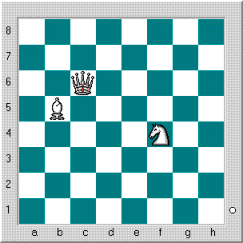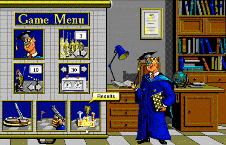Blindfold
by Aleksey Bartashnikov
Blindfold is a chess training computer program. It includes a Test and a Game. It is intended to improve the speed of comprehension and to extend the capacity of operative memory. These two parameters are of great importance both for progress at school and for successes in chess. From point of view of chess this program is aimed at diagnosing and training a chessplayer's intellectual faculties called variations calculation and visualization.
Test
The aim of the Test is to reveal the extent to which your operative chess memory has been developed. That is, how successful you can be in keeping track of the numerous chessboard situations which replace one another during the kaleidoscopic counting of variations. The accuracy of visualization of piece positions and movements in the course of imaginary play determines the degree of correctness of the player's positional evaluation and, consequently, his/her decisions.
Testing Rules
Here is a position to illustrate proper user actions in a test (see Diag.1).

Diag. 1. Initial position of a test
The program incorporates the notion of an interacting pair of pieces. The term refers to a chessmen couple in which one protects the other (or both pieces guard each other). In the diagram position Qc6 protects Ng6 and so the two pieces are regarded by the program as an interacting pair. When the commencement of testing has been confirmed by clicking on the Start button, the program makes a move - 1.Ng6-f4. Then all of the chessmen vanish from the onscreen board and the user has to indicate the square occupied by the piece which interacts with the unit that has just moved. In this particular case the correct square is e2, for it is there that the Knight-protected Bishop stands. As soon as you have indicated the e2-square the program makes its next move - 2.Be2-b5 (see Diag. 2).

Diag. 2. Position after 2.Be2-b5
The previous interacting pair (Nf4-Be2) is no more, but a new pair has been created (Bb5-Qc6). You must indicate the c6-square next. If you indeed do so, the program continues with 3.Qc6-f6, making it necessary for you to point to the f4-square occupied by the Knight, the piece which interacts with Qf6 (Qf6-Nf4). Testing continues in a similar way till it's over. Below are some more moves with which the test may continue:
4.Nd3(Bb5) 5.Bc6(Qf6) 6.Qf2(Nd3) 7.Nb2(Qf2) 8.Qf3(Bc6) 9.Ba4(Nb2) 10.Nd3(Qf3) 11.Qa8(Ba4) 12.Bc2(Nd3) 13.Nb4(Bc2) 14.Be4(Qa8) 15.Qf8(Nb4)
A piece between the brackets is one which interacts with the unit that made the last move. The program has been so designed that there is only one pair of interacting pieces at any moment; each move by the program breaks the earlier interaction while creating a new one in which at least one of the pieces was part of the previous pair. A test is always 40 moves long. Only white pieces are employed. Testing is carried out in a "blind" manner, i.e. the user has no chance to look at the position; all there is to see is the empty chessboard and the trajectory of the piece being moved by the program. If you have: 1) erroneously indicated the square occupied by the interacting piece, 2) exceeded the time limit, 3) used a hint, the program regards your response as incorrect, and prompts you to restore the current position. As soon as the restoration is over testing resumes.
Game Rules
A Game called Dinamic Pairs is intended for maximum development of chessplayer's calculation abilities and visualization. This Game is a good tool to train your blind play as well.
The playing rules of Dinamic Pairs game are almost the same as in testing, with the exception that:
- here you can play a non-blindfold game;
- time limit pertains to the whole game, not to each single move;
- if the time limit was overstepped or an incorrect move was made, the current position is not restored and the player loses;
- no hints are available.
Features
Test and Game have 6 difficulty levels depending on the number of pieces available on the board: the initial level deals with 2 pieces and the last one with 7. In the Test mode the program gives you first a task with just a couple of pieces. If the accuracy of your responses is 95% or higher, you will go over to the next level and deal with a test featuring 3 pieces. For transition to the next level from levels 1-5 you always need to reach the 95% accuracy target. In the Game mode you can set any difficulty level you like.
The game features two regimes - Visible ("seeing" play) and Invisible ("blind" play).
The Visible regime ought to be regarded as an auxiliary training facility. It is intended primarily for chessplayers of relatively low qualification and low ambitions as well as for children. In this regime the chessboard on the screen correctly displays the current position of the game; the pieces are always there and no operations are performed mentally. The Visible regime resembles the analysis of adjourned positions where the player can make each reviewed move on the board and never bother about calculating variations "in the head." Play in this regime serves primarily to develop one's attentiveness, to provide for an integral view of the interaction of pieces on the chessboard, and to speed up comprehension of that interaction.
In the Invisible regime the chess "characters" stay invisible most of the time; a piece only appears for a brief moment to display the program's latest move. This sort of blind play resembles game analysis under real tourney conditions - when a chessplayer cannot move the pieces about and has to calculate possible lines of play in his/her mind only.
The Test has the Invisible regime only.
The main window of the program looks like this:
Click on the image to see it in larger size.
More detail description of the program you will find at the Chess Puzzles Series site (http://www.bartsoft.com/chesspuzzles/).
Blindfold is sold by Bartspft through the Internet for $25. Here is the link where you can download an evaluation copy of the program:
http://www.bartsoft.com/chesspuzzles/blind.htm.
Written by Aleksey Bartashnikov. HTML conversion by David Howe.
WWW page created: September 16, 1998. Last modified: December 14, 2001.

